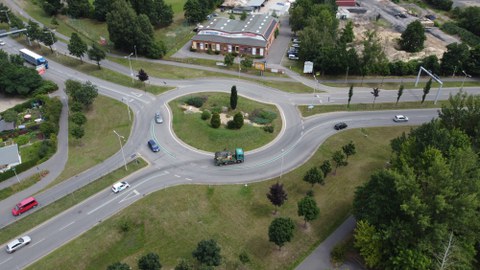Apr 03, 2023
Survey launched on a new generation of roundabouts

Turbo roundabout northeast of Cottbus city centre, South Brandenburg.
Traffic researchers from TU Dresden and Ruhr-University Bochum want to optimise the design, marking and signage of "turbo roundabouts".
Roundabouts have become an integral part of the German road network. In many places they increase traffic safety at junctions and promote traffic flow. Since the 1990s, this type of junction has become widespread throughout Germany. Thirty years later, a new type of roundabout is the focus of a research project that has become more widespread in recent years: "turbo roundabouts".
With these roundabouts, motorists must know exactly which direction (and exit) to take before entering and select the appropriate lane of the roundabout. This involves some risks and requires prudent traffic behaviour from all involved. Traffic researchers at TU Dresden and Ruhr-University Bochum are currently investigating what needs to be considered and how such turbo roundabouts can be designed and used safely and efficiently.
This also includes an online survey. People who regularly participate in road traffic are cordially invited to take part in the survey, which will run until about the end of April - to the survey, duration approx. 10 minutes.
Questions that concern the researchers are:
- What is important at such special roundabouts so that the decision to drive is made in good time?
- How can accidents be avoided?
- What is important to drivers so that they feel safe and oriented?
- How can the approaches to such roundabouts be crossed on foot or by bicycle?
No lane change necessary in the roundabout
Turbo roundabouts have a larger capacity than the classic design of previous roundabouts and can therefore handle more vehicles. There are sometimes several lanes in the approaches and in the circle, and no lane changes are necessary in the circle itself. "Drivers are guided into the correct lane for their destination within the roundabout," explain Julian Schmitz (Ruhr University Bochum), Armin Kollascheck and Martin Bärwolff (both TU Dresden).
In order to optimise the design of such roundabouts, the three traffic researchers have already carried out traffic analyses on turbo roundabouts and also analysed the occurrence of accidents. In addition, they now want to use the survey to determine what attitudes and reservations motorists, cyclists and pedestrians have about turbo roundabouts, what type of signage is considered sensible and how the lanes should be marked or structurally separated to offer the greatest possible orientation.
The survey is part of a research project commissioned by the German Federal Highway Research Institute. The Chair of Integrated Transport Planning and Traffic Engineering at TU Dresden and the Chair of Transport - Planning and Management at the Ruhr University Bochum are involved in the project.
Link to the survey (only in German): https://verkehrswesenrub.limesurvey.net/287725?lang=de
Picture credits: Turbo roundabout northeast of Cottbus city centre, South Brandenburg. Photo: Chair of Integrated Transport Planning and Traffic Engineering/TU Dresden
Media contact:
Martin Bärwolff
Chair of Integrated Transport Planning and Traffic Engineering
“Friedrich List” Faculty of Transport and Traffic Sciences, TU Dresden
Tel.: +49 351 463-36661
Contact person for technical queries about the survey:
Julian Schmitz
Chair of Transport - Planning and Management
Ruhr University Bochum
Tel.: +49 234 32 27587
Author: Anke Richter-Baxendale
